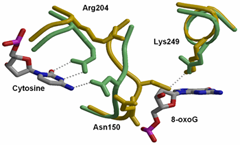
Laboratory for molecular biology
The Laboratory for Molecular Biology investigates basic biological processes associated with cellular responses to DNA damage including DNA repair pathways and mechanism for tolerance, scavenging and adaptation. Focus has been on the repair of endogenous DNA damage and mechanisms for removal of base damage to DNA. At the cellular and organismal level, the aim is to understand mechanisms for genome maintenance in mammalian as well as microbial cells and to develop new interventions for preventing cancer and neurological disease associated with genome instability caused by DNA damage.
Challenges
Cellular genomes are continuously challenged by physical, chemical and biological agents that introduce changes of the chemical structure of the DNA. Intracellular reactive metabolites such as reactive oxygen species and alkylating compounds are important inducers of such changes. Nevertheless, mutation frequencies are low because of very efficient pathways for DNA repair and DNA recombination, which remove DNA damage and conserve at least one functional copy of the genome. Nevertheless, in humans, DNA damage will induce genome instability that is associated with disease and degenerative disorders. Challenges are to understand the mechanisms for cellular protection against DNA damage and its role in cancer, ageing and neurological disease.
Projects
- Alkylation and oxidative DNA damage and repair - role in ageing, cancer and neurological disease
- Functional genomics of DNA repair
- Model studies of DNA repair and ageing in yeast
- RNA genes in biological responses to DNA damage
- Mechanisms of DNA repair and genome maintenance in microbial cells and animal viruses
- Genome stability and maintenance in stem cells
- The WRN premature ageing syndrome and role in DNA recombination
Key achievements
Basic biology of nucleotide excision repair (Nature 263:524-6,
1976; PNAS 75:2569-
73,1978; PNAS 79:988-92,1982; PNAS 87:191-4,1990; EMBO J. 3:757-60,
1994), genetics and mechanisms for repair of alkylation damage to
DNA (JMB 140:101-27,1980; Nature 296:775-7,1982; EMBO J 9:4563-8,1990;
EMBO J 17:363-7,1998; Nature 419:178-82,2002; Nature 421:859-63,2003),
identification, cloning and characterization of genes for repair
of oxidative DNA damage in eukaryotes (PNAS 93:10735-40,1996; EMBO
J 16:6314-22,1997; MCB 19:3779-87,1999; NAR 30:4926-36,2002). Significant
contributions have also been made in the fields of brain glutamate
transport (Nature 360:464-7,1992, Eur. J. Nurosci., 6:936-42,1994),
haematopoiesis (Blood 91:4127-35,1998), and bioinformatics (Bioinformatics
16:699-706,2000).
Group leader
 Professor Magnar
Bjørås
Professor Magnar
Bjørås
Centre for Molecular Biology and Neuroscience
Department of Microbiology
Oslo University Hospital
Rikshospitalet
PO Box 4950 Nydalen
NO-0424 Oslo, Norway
Tel: +47 23074059
Fax: +47 23074061
E-mail: magnar.bjoras@medisin.uio.no

Protein conformational changes associated with DNA damage recognition (hOGG1,Yellow: native; green: bound to DNA)
PO Box 1105 Blindern, NO-0317 Oslo, Norway. Tel: +47 22851528. Fax: +47 22851488